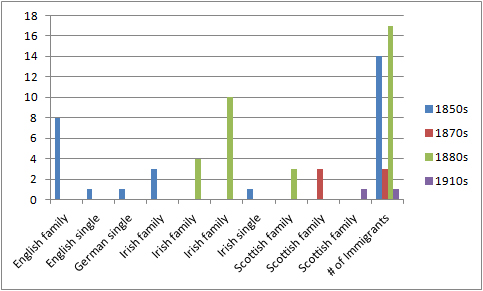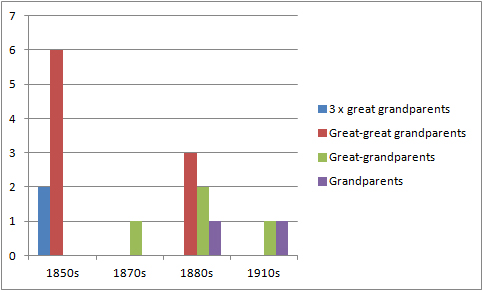The other day I was reading Sharon’s post on Family Statistics. I’ve done statistics on groups of emigrants from Bavaria or Ireland but not my own family’s migration history. I’ve also “mapped” my ancestral places of origin but now how or when they came to Australia. Having realised this omission, and considering my first arrivals to Australia for the 2013 Australia Day Challenge, it was inevitable that I’d have to have a play.
Unlike Sharon there was no point in considering where my ancestors arrived – they are all “true maroon” Queenslanders. I immediately knew that many had arrived in the 1850s but that each side of my family tree had one line that was more recent: one maternal Irish, in the 1880s, and one paternal Scottish in the 1910s, with a middle-range Scottish 1870s. In this graph I plotted all family members who arrived in the migration event whether they were a direct ancestor or not.
Because several migration “events” included multiple generations, I wanted to map my ancestors’ arrival by their ancestral relationship to me. For this purpose I ignored siblings, unrelated spouses, nieces and nephews etc.I also counted each ancestor separately eg my great grandmother and my great grandfather. I was somewhat surprised to realise that my earliest Australian immigrants included my 3 x great grandparents (it’s easy to sometimes lose track of the generations I find).
The question whether they emigrated as singles, couples or families was quickly enough answered in my head, but how would it look on a table and then a graph?
It was clear that, like Sharon, couples with no children hadn’t featured in my family’s migrations, nor do I have any ancestors who arrived as convicts. There were a few hardy singles in the 1850s, and 7 family exoduses en masse from their homelands, sometimes including all the family and some only a couple with a small child or grandchild. My 1880s migration was slightly distorted because two of the migration events were for the same family: in the second case, my great-grandparents left a year after the rest of the family due to the birth of their small child.
I found this exercise fun and informative – thanks Sharon for prompting me to look at this a new way.



What a great idea! My family stats would be less varied – all NSW, all (as far as I know – there are some mysteries) single.
LikeLike
It was fun Frances! All single is a high proportion – I know some were Irish…were they all?
LikeLike
No, there were others from Britain as well.
Put it like this – I haven’t come across a family emigrating… yet.
LikeLike
That’s interesting RebelHand. Singles were very common and women unusually so for emigration theory but that would have been contributed to by the govt’s assisted migration “wish list” for single women and ag labs. When those who were already here started sponsoring their relatives, I’ve seen more families across my Irish study. The family stats can be deceptive because while my Scottish grandmother’s whole family (minus one brother, and deceased father obviously) came out, it was only her elderly mother (oops my age!!) who was sponsored along with a brother who may have been designated as a carer. All the others were assisted immigrants, though they’re hard to find in the archives records. My McSherry/McSharry lot may well have come under railway initiatives. The immediate glance can throw one off with these sorts of records.
LikeLike
Interesting, Pauleen. I have to confess I’ve concentrated on the earlier ones and there are many who I can’t trace. Yet…
LikeLike
After 25 years I still have some I can’t trace RebelHand-only makes me more stubborn and gives me something to keep hunting for. Happy sleuthing 🙂
LikeLike
An interesting task. I am wondering what the ratio of single women was to me?
LikeLike
Bad form to comment on your own post, but I have a typo! – ratio of women to men!
LikeLike
Ah but not a comment, just a correction Julie 😉 Women:Men ratio: A lot depended on the nationality of the emigrants. Emigration theory says single women are much less likely to emigrate and English women were much more reluctant to migrate to Australia on their own than Irish women. At least with my East Clare database the women are either slightly ahead or evenly balanced with the men. In many cases, they were the initial migrant with chain migration following them. The hidden fact is that they were often accompanied by cousins, siblings (even if not identified as such) or friends and neighbours from the same area….I did a lot of number crunching on this with the East Clare mob. The Australian migration was skewed by govt assistance to bring out single women and men. Lots about this in the migration studies which I find fascinating.
LikeLike
I also really liked the idea of crunching the numbers, so I’ve used Sharon’s post as an inspiration for one of my own, but I also like the way you have done the analysis of how many people came from what country which is also very interesting, something that I should also have a go at. It’s a shame I ran out of time .. must get some house work done! but it would also be interesting to analyse if people came out as children or as parents etc. Much food thought,
LikeLike
Thanks Sandra, I’m glad it gave you some fun…you didn’t add a blog link but would appreciate a peek-a-boo. Personally I’m dodging the house work right now but will have to do it soon!
LikeLike
HI Cassmob, I’m relatively new to to the blogosphere, so I’m never sure whether it’s OK to add in links or not when making posts, my blog is at http://ancestralresearchjournal.blogspot.com.au/
Cheers, Sandra
LikeLike
That’s fine Sandra…I am pleased you’ve provided your link & I’m off to have a look. I hope you enjoy your life in the blogosphere -it’s certainly addictive 😉
LikeLike
Not Australian, and dinna have Australia Day here in Southern Oregon, but I am interested in your stats. What program or site did you use for your stats? or just regular old excel?
LikeLike
Yep, just regular old Excel Joan, with graphs inserted then copied across to Photoshop (may be an easier way but that’s what I do). I found it quite interesting to do this exercise.
LikeLike
Looks like a really interesting exercise. Would that I could do one. Not trying to be glum.
LikeLike
My first thought was “of course you’d be able to figure this out” then realised you meant it’s yet another “casualty” of having slave ancestors. I’d be glum I think.
LikeLike
Well, I guess it’s sort of a back of my mind permanent glum but oh well. You start in the 1850s, I can trace migrations around the USA from that time using census records and where people say they were born. But I can’t go back to before they were here except for dna which is such a broad placement most of the time.
LikeLike
I’d imagine so Kristin (re glum). You have census records which we don’t but we have electoral rolls (theoretically compulsory). All swings and roundabouts really. Having to rely on DNA would be annoying given it’s broad parameters.
LikeLike
Your post Pauleen has me asking if my singles also arrived in the 1850s. I can immediately think of three who did.
LikeLike
I find the marital status data interesting but also whether they may have travelled with friends/family as many Irish, in particular, did.
LikeLike